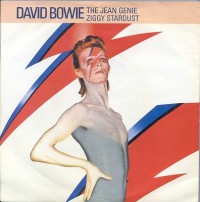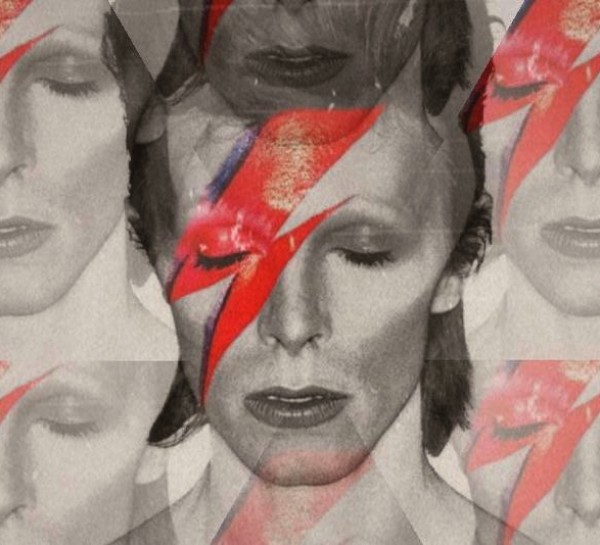Some blogs do Shark Week, here at Phawker we’re more inclined to do a Bowie Week. In case in you haven’t noticed, we’re in the middle of one. Enjoy.
SLATE: At the time I was working in a tragique department store outside London. I was in “clocks and watches,” and my best friend Biddie—later to become James Biddlecombe, star of panto and cabaret—worked  in “soft furnishings.” This was a really grim period. Our lives were seedy and turgid, and we were in desperate need of some satin and tat, to mention nothing of a frock coat and a bipperty-bopperty hat. We divided our time between dodging the Reading skinheads and mocking the local gays in their fluffy sweaters who congregated in the functions room of a dismal pub near the train station. That’s how grim our lives were. But then, on that hot, smelly night in Finsbury Park, we found Bowie, the leper messiah, the new patron saint of marginalized freaks, and we began tarting ourselves up.
in “soft furnishings.” This was a really grim period. Our lives were seedy and turgid, and we were in desperate need of some satin and tat, to mention nothing of a frock coat and a bipperty-bopperty hat. We divided our time between dodging the Reading skinheads and mocking the local gays in their fluffy sweaters who congregated in the functions room of a dismal pub near the train station. That’s how grim our lives were. But then, on that hot, smelly night in Finsbury Park, we found Bowie, the leper messiah, the new patron saint of marginalized freaks, and we began tarting ourselves up.
Biddie, with his long neck and henna’d tufts, was able to make himself look exactly like Bowie in his Ziggy incarnation, so much so that girls would sometimes scream and ask for his autograph even while he was at work on a wet Wednesday afternoon. I guess it never occurred to them to wonder what the world’s most exciting new pop phenomenon was doing in a suburban department store slicing up bolts of chintz and brocade. The more Biddie and I discovered about Bowie, the more deranged our fan worship became. We just had oodles in common. We were all stuck in the same depressed, post-hippie quagmire, and we were attempting to claw our way out with the aid of sequins and extreme theatricality. Like Bowie, we loved Lindsay Kemp and Scott Walker and Jacques Brel. And we loved Anthony Newley. I was “The Laughing Gnome.” Still am.
Biddie may have looked just like Bowie, but my Bowie solidarity was more profound than his. Like DB, I grew up with a lobotomy and smattering of schizophrenics. As a result, I, too, lived in star of panto and cabaret—worked  ifear of losing my shit. When I saw Bowie onstage at the Rainbow in his futuristic costumes and space boots, I was filled with hope. Here was the antidote to life in the local mental institution. The way to avoid going nuts was to go glam rock. Bowie was living proof: Getting tarted up imbued the wearer with power and immunity. Wearing a striped, twinkle-knit unitard with one leg missing is the opposite of wearing a straitjacket. I think we can all agree about that. MORE
ifear of losing my shit. When I saw Bowie onstage at the Rainbow in his futuristic costumes and space boots, I was filled with hope. Here was the antidote to life in the local mental institution. The way to avoid going nuts was to go glam rock. Bowie was living proof: Getting tarted up imbued the wearer with power and immunity. Wearing a striped, twinkle-knit unitard with one leg missing is the opposite of wearing a straitjacket. I think we can all agree about that. MORE
OPEN CULTURE: Bowie had fronted a number of derivative R&B groups in the early sixties under his given name Davy (or Davie) Jones. Since his name invited confusion with the then-famous Monkee, he changed it in 1967 and released his first single as David Bowie, a creepy novelty record called The Laughing Gnome, which was included on his first self-titled album. The album, “a strange mix of musical and pop,” was inspired by light comic entertainer Anthony Newley–whose “surreal comedy paved the way for Monty Python”–and it was a failure. But, Cocker informs us, Bowie was learning from his mistakes: “Newley’s quirky versatility would inform the theatrical DNA of Ziggy Stardust.” Bowie was casting around, trying to find a persona to suit the latent talent it seemed only he believed in. His longtime drummer Woody Woodmansey says above, “he was going through a trial and error period, and there was a lot of error.”
One breakthrough came when he met dancer Lindsay Kemp, who taught him mime and with whom Bowie toured in a theater production and had an affair. During these years of seeming failure, Bowie ilearned all of the skills that he would use to construct Ziggy: dance, mime, stage and television acting, and sexual expression. As Kemp tells it, “he had an enormous sexual appetite”—a central part of Ziggy, and Bowie’s, pull. Another breakthrough came with 1970’s “Space Oddity, which hit #5 on the UK charts. But the album of the same name did not fare well. Filled with star of panto and cabaret—worked  meandering psych-folk ballads more Donovan than Queen Bitch, Space Oddity disappointed. Bowie had not yet found his voice, nor his muse, and he would not until he met his first wife Angie, who “made him brave” and helped him put together his first glam-rock project The Hype, with guitarist Mick Ronson. The hype went nowhere, but Ronson and Bowie collaborated on his next album, The Man Who Sold the World.
meandering psych-folk ballads more Donovan than Queen Bitch, Space Oddity disappointed. Bowie had not yet found his voice, nor his muse, and he would not until he met his first wife Angie, who “made him brave” and helped him put together his first glam-rock project The Hype, with guitarist Mick Ronson. The hype went nowhere, but Ronson and Bowie collaborated on his next album, The Man Who Sold the World.
Finally, says Bowie, after those years of near-obscurity, “somebody did come along and grab me by the empty wallet and said, I’m Tony Defries and I’m going to make you a star.” Defries introduced him to Andy Warhol’s New York scene and he became something of a scenester himself, but he was still too shy to fully inhabit Ziggy Stardust, so he used a surrogate—a fashion designer named Freddie Burretti. Burretti was to serve as the face, while Bowie wrote and sang the songs. He called the project “Arnold Corns.” Bowie produced the Arnold Corns record with many of the songs that would eventually make it to the Ziggy Stardust album—including “Moonage Daydream”—but they were rudimentary and flat and the project was a failure, though the idea lived on while Bowie wrote and recorded Hunky Dory with Ronson, Woody Woodmansey, and Trevor Bolder, the lineup of Ziggy’s future Spiders From Mars. Just two weeks after the 1972 wrap of Hunky Dory, the sessions for Ziggy Stardust and the Spiders from Mars began. MORE
PREVIOUSLY: Steve Volk’s Insta-Review Of The New Bowie Album
PREVIOUSLY: When Bowie Met Kraftwerk And Blew Madonna’s Mind
PREVIOUSLY: Dan Buskirk’s Review Of THE MAN WHO FELL TO EARTH Re-Release
PREVIOUSLY: Will Farrell & John C. Reilly ARE Bowie & Bing

